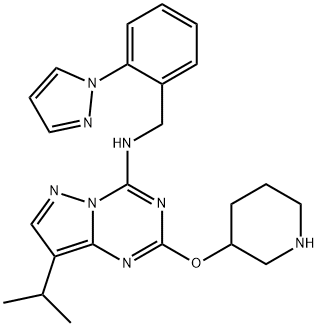Description
LDC-4297 is an inhibitor of cyclin-dependent kinase 7 (CDK7; IC
50 = <5 nM). It is selective for CDK7 over CDK4, CDK6, and CDK9 (IC
50s = >10, >10, and 1.71 μM), however, it also inhibits CDK2 and CDK1 (IC
50s = 6.4 and 53.7 nM, respectively). LDC-4297 (10-100 nM) induces apoptosis in A549, HeLa, and HCT116 cancer cells in a concentration-dependent manner. It inhibits human cytomegalovirus (HCMV) replication in human fibroblasts (EC
50 = 24.5 nM). LDC-4297 also reduces replication of
Herpesviridae,
Adenoviridae,
Poxviridae,
Retroviridae, and
Orthomyxoviridae family viruses (EC
50s = 0.02-1.13 μM).
Uses
Cyclin-dependent protein kinase 7 (CDK7) is involved with a broad range of regulatory roles in cell cycle and transcription, which is essential for viral replication. LDC 4297 is a CDK7 inhibitor that can be used to develop antiviral drugs.
Definition
ChEBI: LDC4297 is a pyrazolotriazine that is pyrazolo[1,5-a][1,3,5]triazine substituted by a piperidin-3-yloxy group, [2-(1H-pyrazol-1-yl)benzyl]nitrilo group and an isopropyl group at positions 2, 4 and 8 respectively. It is a potent and selective CDK7 inhibitor and exhibits antiviral activity. It has a role as an EC 2.7.11.22 (cyclin-dependent kinase) inhibitor, an apoptosis inducer, an antineoplastic agent and an antiviral agent. It is a pyrazolotriazine, a member of pyrazoles, a member of piperidines, a secondary amino compound and an aromatic ether.
